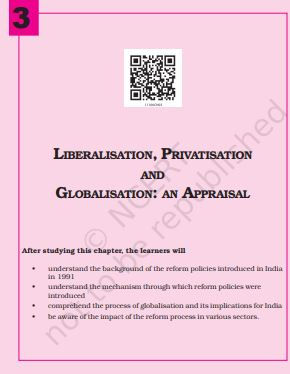‘NCERT Solutions for Class 11 Economics Chapter 3 Liberalisation, Privatisation and Globalisation: An Appraisal‘ PDF Quick download link is given at the bottom of this article. You can see the PDF demo, size of the PDF, page numbers, and direct download Free PDF of ‘Ncert Class 11 Economics Chapter 3 Exercise Solution’ using the download button.
Liberalisation, Privatisation and Globalisation: An Appraisal NCERT Textbook With Solutions Book PDF Free Download

Chapter 3: Liberalisation, Privatisation, and Globalisation: An Appraisal
You have studied in the previous chapter that, since independence, India followed the mixed economy framework by combining the advantages of the capitalist economic system with those of the socialist economic system.
Some scholars argue that, over the years, this policy resulted in the establishment of a variety of rules and laws, which were aimed at controlling and regulating the economy, ended up instead hampering the process of growth and development.
Others state that India, which started its developmental path from near stagnation, has since been able to achieve growth in savings, developed a diversified industrial sector that produces a variety of goods, and has experienced a sustained expansion of agricultural output which has ensured food security.
In 1991, India met with an economic crisis relating to its external debt the government was not
able to make repayments on its borrowings from abroad; foreign exchange reserves, which we
generally maintain to import petroleum and other important items, dropped to levels that were not sufficient for even a fortnight.
The crisis was further compounded by the rising prices of essential goods.
All of these led the government to introduce a new set of policy measures that changed the direction of our developmental strategies.
In this chapter, we will look at the background of the crisis, measures that the government has adopted, and their impact on various sectors of the economy.
The origin of the financial crisis can be traced to the inefficient management of the Indian economy in the 1980s.
We know that for implementing various policies and its general administration, the government generates funds from various sources such as taxation, running of public sector enterprises, etc.
When expenditure is more than income, the government borrows to finance the deficit from banks and also from people within the country, and from international financial institutions. When we import goods like petroleum, we pay in dollars which we earn from our exports
Development policies required that even though the revenues were very low, the government had to overshoot its revenue to meet challenges like unemployment, poverty, and population explosion.
The continued spending on development programs of the government did not generate additional revenue. Moreover, the government was not able to generate sufficiently from internal sources such as taxation.
When the government was spending a large share of its income on areas that do not provide immediate returns such as the social sector and defense, there was a need to utilize the rest of its revenue in a highly efficient manner.
The income from public sector undertakings was also not very high to meet the growing expenditure.
At times, our foreign exchange, borrowed from other countries and international financial institutions, was spent on meeting consumption needs.
Neither was an attempt made to
reduce such profligate spending nor sufficient attention was given to boost exports to pay for the growing imports.
| Author | NCERT |
| Language | English |
| No. of Pages | 21 |
| PDF Size | 1.9 MB |
| Category | Economics |
| Source/Credits | ncert.nic.in |
NCERT Solutions Class 11 Economics Chapter 3 Liberalisation, Privatisation and Globalisation: An Appraisal
1. Why were reforms introduced in India?
Reforms were introduced in the year 1991 due to the following reasons:
1. To manage the economic crisis that the country was going through
2. Fiscal deficit was going through the worst phase during that period and that resulted in increased public debt.
3. India was going through a weak Balance of Payments (BOP) scenario. With the fall of the erstwhile the Soviet Union and the Gulf War, it led to borrowing from the International market. Finally, this led to the formation of a new economic policy to attain a balanced economy.
4. PSU’s were established with the aim of providing employment and removing poverty. But the PSUs turned out to be loss-making units, which burdened the already weak economy of the country.
5. High level of fiscal deficit lead to RBI increasing the inflation rate, which made goods more costly and led to the starting of a movement from within.
2. Why is it necessary to become a member of WTO?
Becoming a member of WTO (World Trade Organisation) is important in many ways as mentioned below:
1. Being a member of WTO, a member country gets equal rights as other member countries to trade in the international market.
2. It provides scope to produce more at a large scale so that it can cater to needy people across boundaries.
3. WTO will work towards abolishing tariff barriers in order to encourage healthy competition among producers of different countries
4. Member countries of WTO that have a similar economic status can raise voices to safeguard common interests.
3. Why did RBI have to change its role from the controller to facilitator of the financial sector in India?
RBI’s role prior to liberalization was to control and regulate the financial sector which comprises of financial institutions such as commercial banks, stock exchange, investment banking, foreign exchange or forex as it is called now.
With the liberalization and reforms undertaken for the finance sector, RBI assumed the role of a facilitator in order to allow financial institutions to make their own decision.
This led to the entry of foreign players. The main objective of financial reforms was to obtain foreign investment and participation from the private sector, to increase competitiveness in the finance sector.
NCERT Class 11 Economics Textbook Chapter 3 With Answer PDF Free Download
